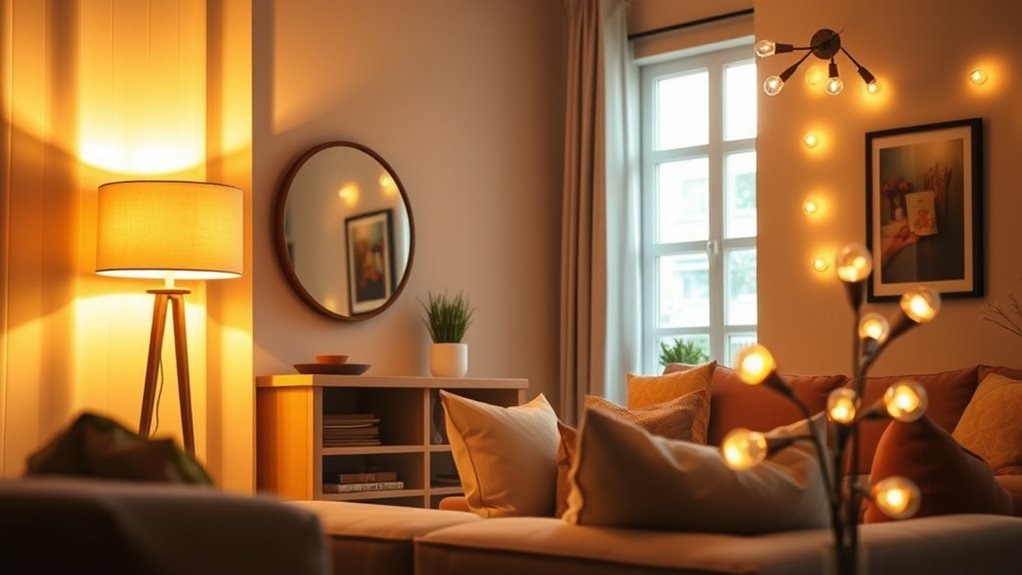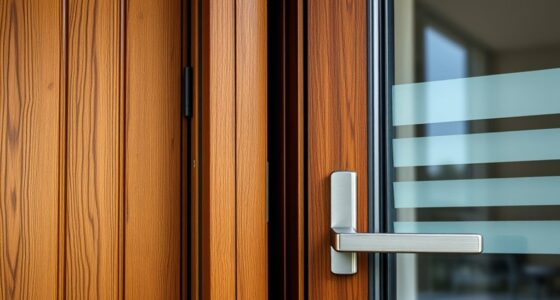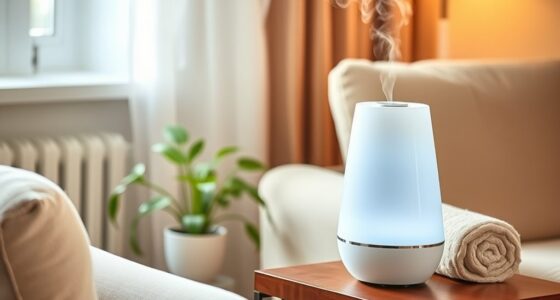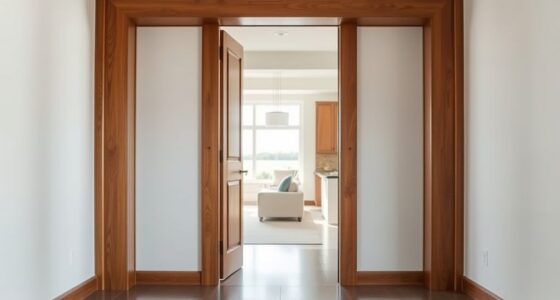To quickly boost your home’s lighting, swap out old bulbs for energy-efficient LEDs that cast brighter, more consistent light. Use mirrors and light-colored walls to reflect natural sunlight and amplify brightness. Add under-cabinet and accent lighting to improve task visibility and create a layered, inviting glow. Rearrange furniture or switch window treatments to maximize daylight entry. These simple changes can instantly transform your space—keep exploring for more easy tips to brighten your home even further.
Key Takeaways
- Replace outdated bulbs with energy-efficient LED options for immediate brightness and cost savings.
- Use mirrors opposite windows to reflect natural light deeper into rooms quickly.
- Clean windows and fixtures regularly with microfiber cloths to maximize brightness and clarity.
- Incorporate light-colored walls and reflective surfaces to enhance natural and artificial light.
- Add under-cabinet or task lighting in key areas to improve functionality and brightness instantly.
Swap Out Old Bulbs for Energy-Efficient LED Options
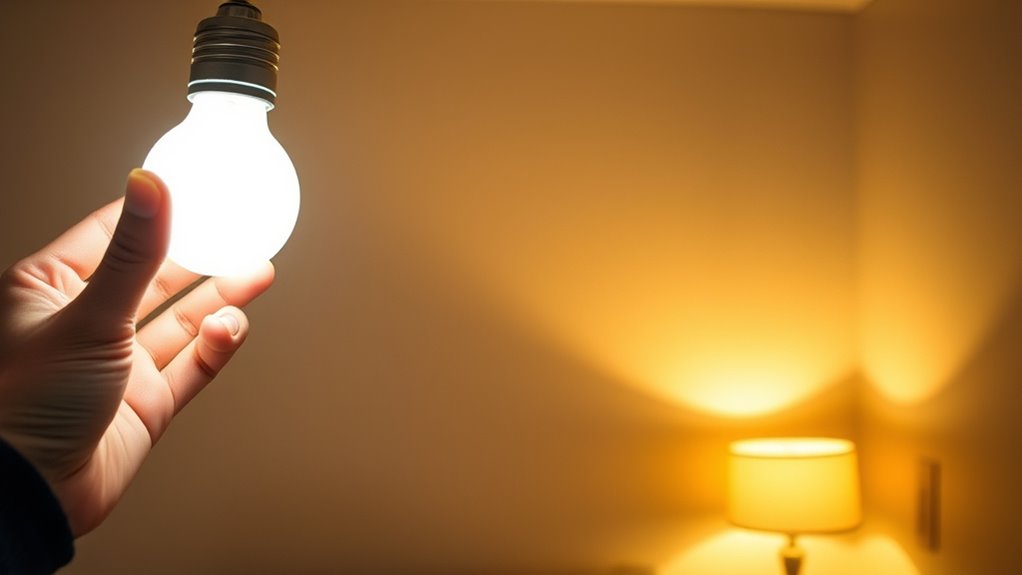
Replacing your old light bulbs with energy-efficient LED options is one of the simplest ways to improve your home’s lighting and save money. LEDs use considerably less energy than incandescent or CFL bulbs, which means lower electricity bills. They also last much longer—sometimes up to 25,000 hours—reducing the frequency of replacements. When choosing LEDs, look for the right brightness and color temperature to suit each space. Warm tones create a cozy feel, while cool tones are better for tasks and workspaces. Swapping bulbs is quick and easy—just turn off the power, remove the old bulb, and screw in the new LED. This small change can make a noticeable difference in both your home’s ambiance and your monthly expenses. Additionally, optimizing your lighting setup can contribute to a better work-life balance, especially when creating a comfortable environment at home.
Use Mirrors to Reflect and Amplify Natural Light
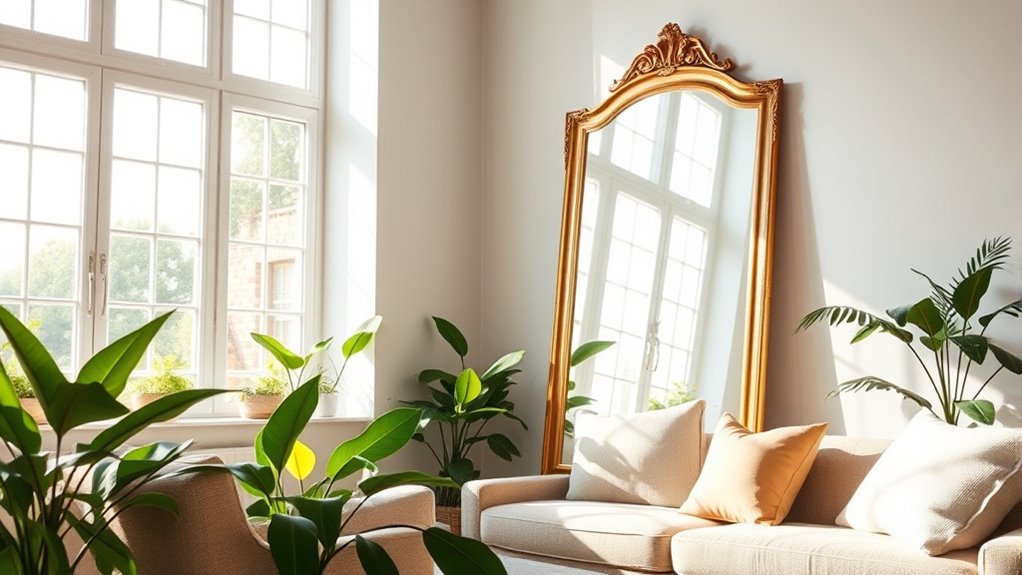
Adding mirrors strategically around your home can substantially boost natural light and make your space feel brighter and more open. Place them opposite windows to reflect sunlight deeper into rooms, or position them near light-colored walls to amplify brightness. Mirrors bounce light around, reducing dark corners and creating an airy atmosphere. To maximize impact, choose large or multiple smaller mirrors grouped together. Keep in mind that the placement should enhance sunlight flow without causing glare. Here’s a quick comparison of mirror placements:
| Placement Idea | Effect |
|---|---|
| Opposite windows | Reflects sunlight into darker areas |
| Near light-colored walls | Amplifies overall brightness |
| Behind light sources | Distributes light evenly |
| On closet doors | Adds brightness to smaller spaces |
Additionally, using professional lighting techniques can further enhance the natural illumination you create with mirrors.
Opt for Light-Colored Paints and Decor to Brighten Spaces
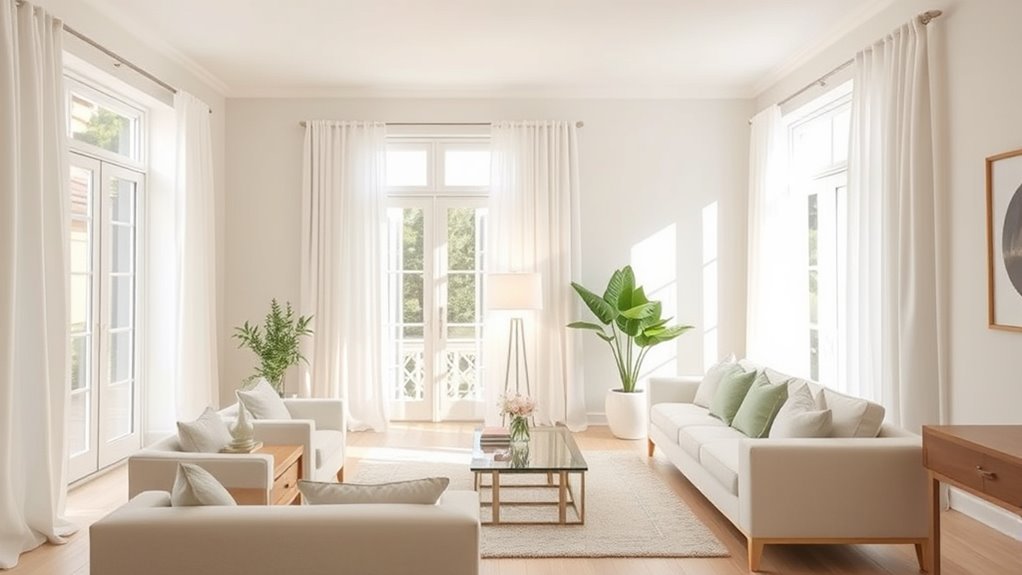
Choosing light-colored paints and decor can make your rooms feel brighter and more open. These shades reflect more light, amplifying your existing illumination. As a result, your space looks more inviting and well-lit with less effort. Incorporating artistic expression into your home through color choices can also foster a more inspiring environment.
Reflects More Light
Light-colored paints and decor can instantly brighten up your space by reflecting more natural and artificial light. When you choose whites, creams, or pastels, you maximize light reflection, making rooms feel more open and airy. These surfaces bounce light around the room, reducing shadows and dark corners. To illustrate, consider the impact of different wall colors:
| Color Type | Light Reflection Effect |
|---|---|
| Bright White | Highest reflection, maximizes brightness |
| Soft Pastels | Good reflection, adds subtle warmth |
| Dark Colors | Absorbs light, dulls the space |
| Neutral Tones | Moderate reflection, balances light |
| Deep Hues | Minimal reflection, darkens the room |
Using light colors strategically helps your space look brighter without extra fixtures. Additionally, incorporating vintage or rustic decor in lighter shades can enhance farmhouse bedroom charm by reflecting even more light and creating a welcoming atmosphere.
Enhances Room Brightness
Opting for light-colored paints and decor instantly boosts your room’s brightness by reflecting more light. Bright hues like whites, creams, pastels, or soft grays make your space feel more open and airy. These colors bounce natural and artificial light around the room, reducing dark corners and shadows. When you choose lighter shades for walls, ceilings, and decor, you enhance the overall illumination without adding extra fixtures. This simple change creates an inviting, lively atmosphere that requires less effort to brighten. Pairing light colors with reflective surfaces like mirrors or metallic accents further amplifies the effect. Keep in mind, choosing the right shades is key; avoid dark, heavy colors that absorb light and make the room feel smaller and gloomier. Incorporating light-colored dog names can also add a cheerful vibe to your space.
Add Under-Cabinet Lighting in Kitchens and Work Areas
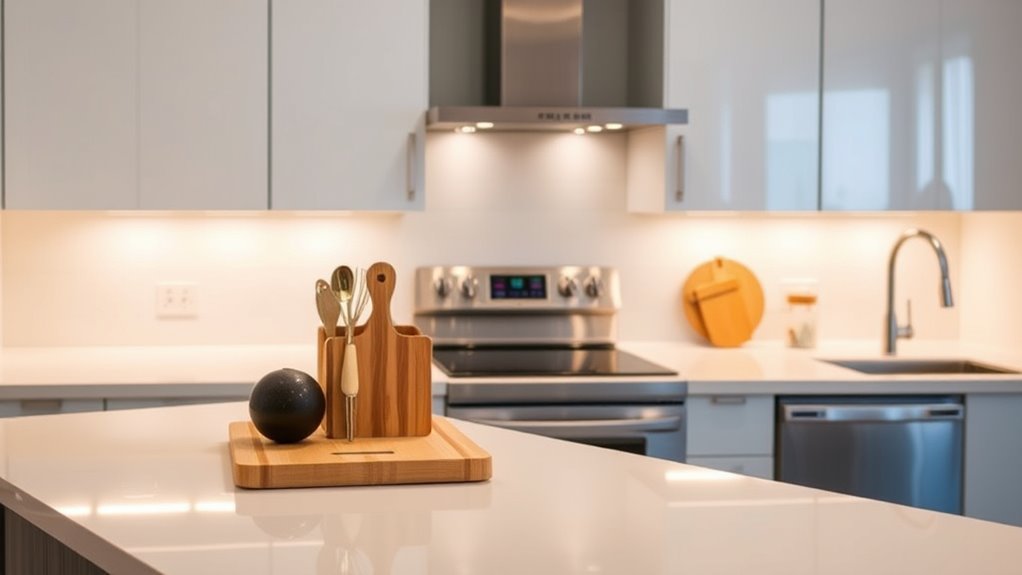
Adding under-cabinet lighting in kitchens and work areas is one of the easiest ways to improve task visibility and create a welcoming ambiance. It illuminates countertops and work surfaces, making meal prep and other tasks safer and more efficient. You can choose from LED strips, puck lights, or tape lights, depending on your space and style. Installing these lights is straightforward—simply attach them under cabinets, plug in, and adjust for even coverage. This small upgrade eliminates shadows and dark corners, instantly brightening your space. Plus, under-cabinet lighting adds a modern touch without overwhelming your decor. It’s a simple, cost-effective change that elevates both functionality and atmosphere in your kitchen or work area. Proper installation ensures consistent illumination, enhancing the overall effectiveness of your lighting setup.
Incorporate Accent and Task Lighting for Flexibility
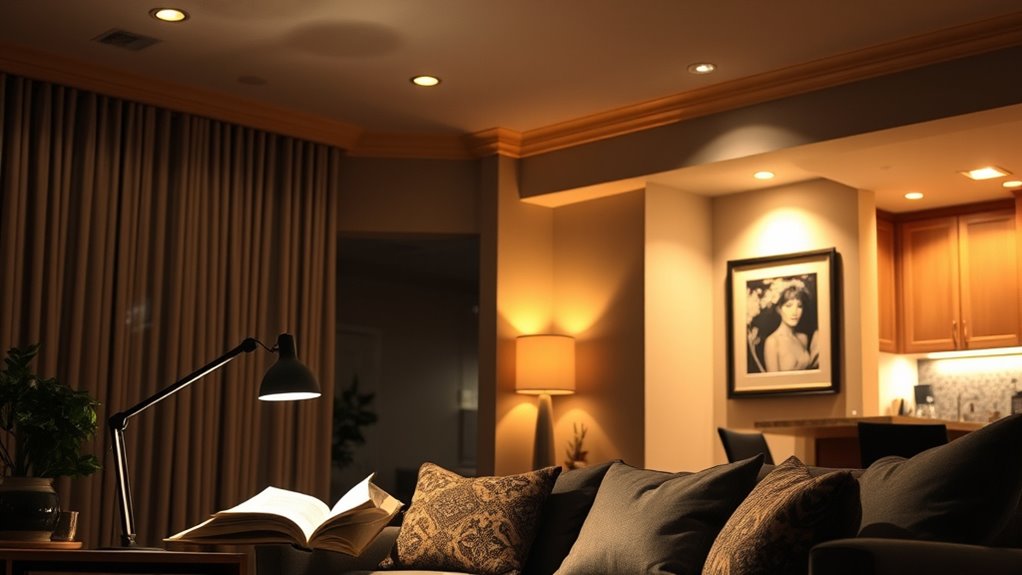
Incorporating accent and task lighting gives you the flexibility to customize your space for different activities and moods. Accent lighting highlights artwork, architectural features, or décor, creating focal points and adding depth. Task lighting provides focused illumination for specific activities like reading, cooking, or working. To maximize this versatility, consider:
- Installing adjustable wall sconces or picture lights for artwork or focal points
- Using under-cabinet lights in kitchens or workspaces for precise task illumination
- Adding desk or floor lamps that can be repositioned for different tasks or moods
- Incorporating dimmer switches to control light intensity and set the right ambiance
- Exploring the benefits of layered lighting to create a balanced and adaptable environment
These small updates enhance functionality while creating a warm, inviting atmosphere tailored to your needs.
Clean Windows and Light Fixtures Regularly to Maximize Brightness
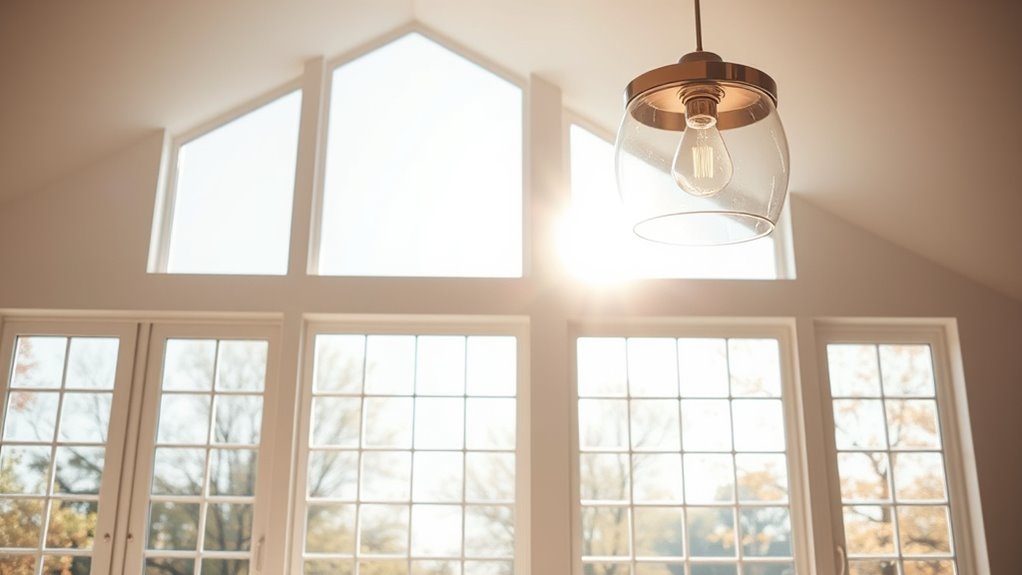
To keep your home as bright as possible, it’s key to clean your windows and light fixtures regularly. Using the right tools and effective cleaning products makes the job easier and guarantees a streak-free shine. Scheduling routine maintenance helps maintain maximum brightness all year round. Additionally, paying attention to celebrity lifestyle insights can inspire stylish and functional updates to your lighting decor.
Use Proper Cleaning Tools
Regularly cleaning your windows and light fixtures with the right tools can make a noticeable difference in your home’s brightness. Using proper tools guarantees thorough cleaning without damage, maximizing light reflection. Here are essential tools to keep on hand:
- Microfiber cloths for streak-free windows and fixtures.
- Extendable duster for reaching high or awkward spots.
- Soft-bristle brush for removing dust from delicate surfaces.
- Spray bottles filled with a gentle cleaning solution for effective dirt removal.
Choosing tools suited for your surfaces to avoid scratches or streaks is crucial. Microfiber cloths are versatile for both glass and fixtures, while extendable tools save you from unsafe stretching or climbing. Proper tools make cleaning faster, easier, and more effective, helping your home shine brighter. Additionally, understanding cleaning techniques can further enhance your results and maintain your home’s brightness.
Schedule Regular Maintenance
Scheduling consistent cleaning for your windows and light fixtures guarantees they stay free of dust and grime that can dim your home’s brightness. Regular maintenance ensures your lighting remains at its brightest and most efficient. Set a routine, whether weekly or biweekly, to wipe down glass surfaces and fixtures. Use a microfiber cloth and a gentle cleaner to remove smudges, fingerprints, and dust buildup. Clean windows on a cloudy day to prevent streaks, and dust light fixtures gently to avoid damaging delicate components. By staying consistent, you’ll prevent dirt from accumulating and blocking light. Regularly inspecting and replacing filters and bulbs can also improve light output and energy efficiency. This simple habit keeps your home naturally brighter, reduces the need for artificial lighting, and prolongs the life of your fixtures. Make maintenance a regular part of your cleaning routine for ideal brightness.
Choose Effective Cleaning Products
Choosing the right cleaning products is essential for maintaining maximum brightness in your home. Using the wrong cleaners can leave streaks or residue that dull surfaces. To make sure your windows and fixtures shine, follow these tips:
- Use a streak-free glass cleaner for windows and mirrors.
- Opt for a mild, non-abrasive cleaner for light fixtures.
- Avoid ammonia-based products that can damage delicate surfaces.
- Use microfiber cloths to wipe surfaces without leaving lint or scratches.
- Regular cleaning with appropriate products can also help prevent buildup and maintain optimal brightness over time, especially when combined with understanding cleaning product types and their effects.
Rearrange Furniture to Avoid Blocking Light Sources
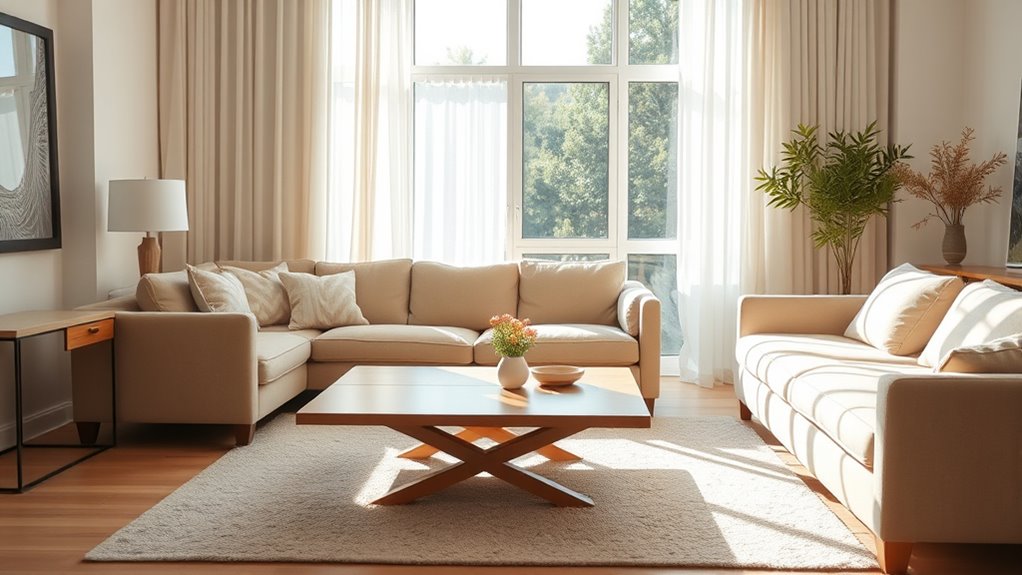
To maximize natural light in your home, it’s essential to arrange your furniture so that it doesn’t block light sources. Start by positioning larger furniture away from windows and doors, allowing sunlight to flow freely into the room. Avoid placing bulky pieces directly in front of windows, as they obstruct light and create shadows. Consider floating sofas or chairs in the middle of the room to keep pathways open and light unobstructed. Use smaller or transparent furniture near windows to maintain brightness while providing functional space. Regularly reassess your layout, especially if you add new pieces or change room functions. Proper furniture placement guarantees maximum daylight, making your space feel brighter, more inviting, and energy-efficient. Recognizing the importance of natural light can significantly improve your overall well-being and reduce your reliance on artificial lighting.
Introduce Light-Enhancing Window Treatments
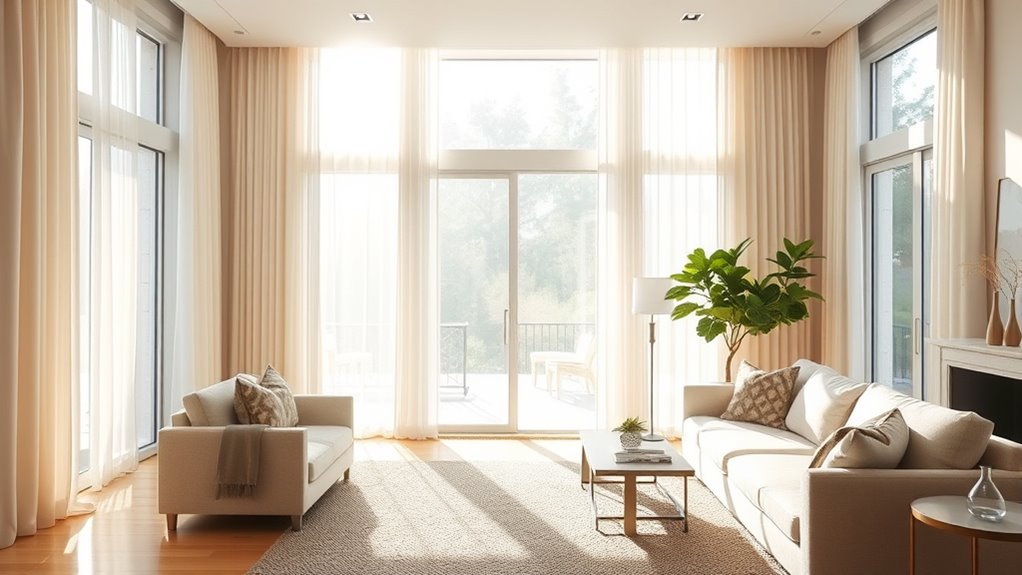
Introducing light-enhancing window treatments can substantially boost the brightness of your home. The right choices can maximize natural light and create a more inviting space. Consider these options:
- Use sheer curtains that allow sunlight to filter through while maintaining privacy.
- Opt for light-colored or reflective blinds to bounce light around the room.
- Install layering with blinds and curtains to control light levels effectively.
- Choose minimal or no-fringe window coverings to prevent obstruction of sunlight.
- Selecting eco-friendly materials for your window treatments can also contribute to sustainable living while enhancing light diffusion.
These simple updates can make your windows more effective at letting in daylight, reducing the need for artificial lighting. By selecting treatments that reflect or diffuse light, you’ll brighten your home naturally and create a more cheerful atmosphere.
Place Lamps Strategically to Eliminate Shadows
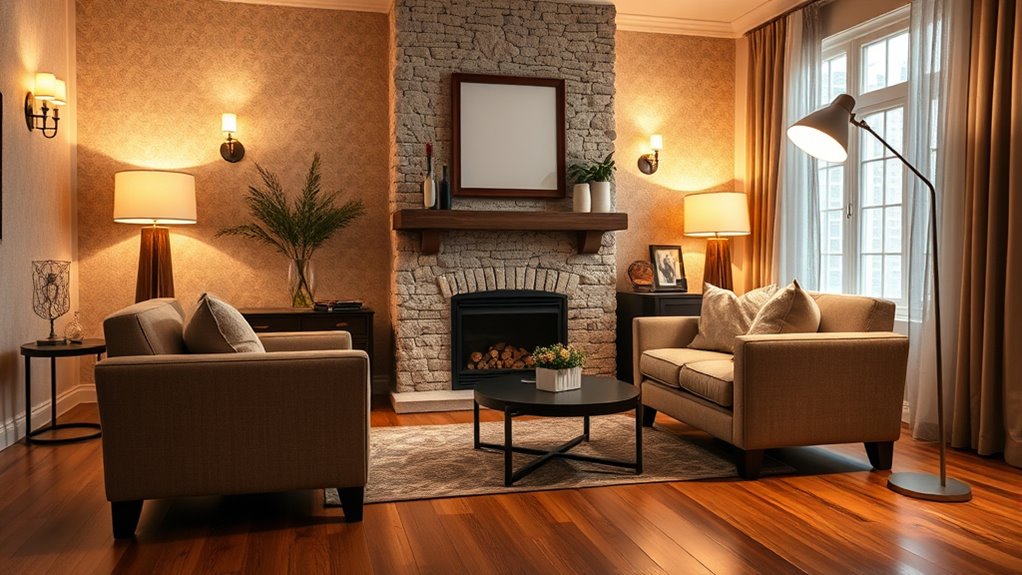
Placing lamps in the right spots can instantly reduce shadows and brighten your space. Use corner lamps to fill in dark corners and create a more even glow. Adding task lighting where you need focused light, like on desks or reading areas, makes a big difference. Incorporating layered lighting techniques ensures balanced illumination throughout your home.
Use Corner Lamps
Strategically positioning corner lamps can substantially reduce shadows and improve overall lighting in your home. By placing lamps in the corners of rooms, you create ambient light that fills dark spots and softens harsh shadows. To maximize their effectiveness, consider these tips:
- Choose lamps with upward-facing shades to bounce light off the ceiling, spreading it evenly.
- Position lamps close to the corner walls for a wider, more uniform light distribution.
- Use dimmable bulbs to adjust brightness based on your needs.
- Pair corner lamps with other light sources for layered, balanced illumination.
- Ensure proper placement of light fixtures can enhance home lighting effectiveness and reduce shadowing.
This simple change helps distribute light more evenly, making your space feel brighter and more inviting without overwhelming glare.
Add Task Lighting
Adding task lighting is a practical way to target specific areas and eliminate shadows that can make a room feel dim or uneven. You can place lamps near reading corners, kitchen counters, or workspaces to brighten these zones. Proper placement guarantees light shines directly where needed, reducing eye strain and improving functionality. Use different types of fixtures—desk lamps, under-cabinet lights, or adjustable lamps—to customize illumination. Keep in mind the following tips:
| Area | Recommended Fixture | Placement Tips |
|---|---|---|
| Reading nook | Adjustable desk lamp | Position at eye level for comfort |
| Kitchen counters | Under-cabinet lighting | Mount close to work surface |
| Workspaces | Task lamps with flexible arms | Focus light on specific tasks |
| Living rooms | Floor lamps or table lamps | Place near seating for ambiance |
Additionally, considering the contrast ratio of your lighting setup can help create a more balanced and visually comfortable environment. Strategically added task lighting boosts functionality and creates a balanced, inviting space.
Incorporate Reflective and Transparent Decor Elements
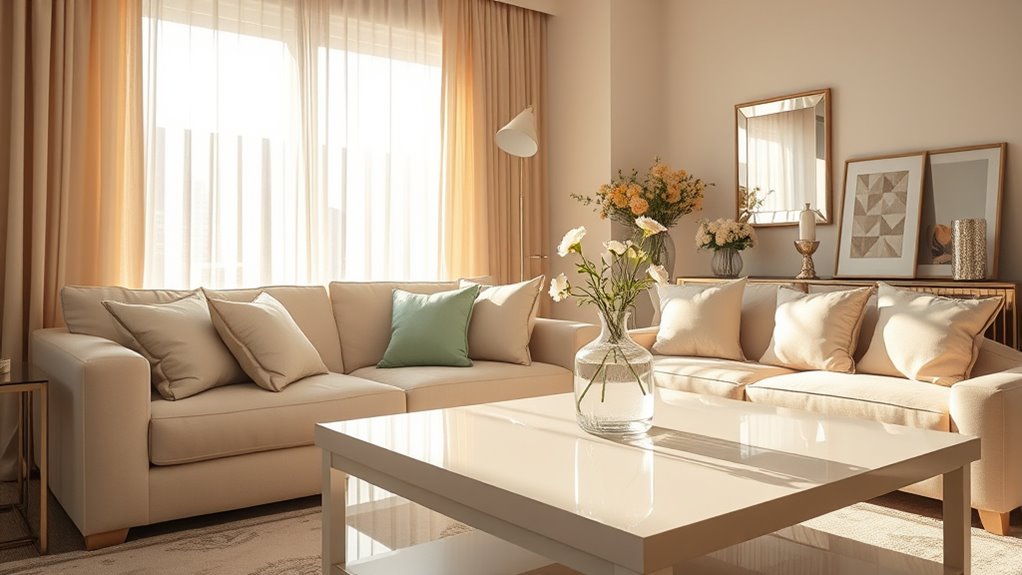
Incorporating reflective and transparent decor elements can substantially enhance your home’s lighting by amplifying natural and artificial light sources. These elements bounce or transmit light, making spaces feel brighter and more open. To maximize this effect, consider:
- Using mirrors strategically across from windows or light fixtures to reflect light.
- Choosing glass or acrylic furniture that allows light to pass through.
- Adding metallic or glossy accents, such as frames or decor pieces, to reflect light.
- Incorporating transparent or semi-transparent curtains that let in daylight without sacrificing privacy.
- Selecting light-reflective surfaces like polished tiles or metallic finishes to further boost illumination.
These small adjustments can make a noticeable difference in how your space feels, reducing the need for additional lighting and creating a more inviting atmosphere.
Frequently Asked Questions
How Can I Determine the Best Wattage for My Room’s Lighting Needs?
Sure, because choosing the perfect wattage is just like picking a magic number, right? Actually, you should start by considering your room’s size and purpose. For general lighting, aim for 20 lumens per square foot. Check your bulb’s lumens, not wattage, since LED bulbs use fewer watts for the same brightness. Adjust based on how bright you want the space, and you’ll find the sweet spot effortlessly.
What Are the Best Placements for Task Lighting in Small Spaces?
You should place task lighting where you need focused illumination, like above your kitchen counter, near your reading chair, or over your work desk. Position fixtures at an appropriate height to reduce glare and shadows, ensuring the light is directed onto the task area. Use adjustable or wall-mounted lights to maximize flexibility, and avoid placing lights too far away, which can cause insufficient brightness for detailed activities.
How Often Should I Replace Light Fixtures for Optimal Brightness?
Think of your light fixtures as the heartbeats of your space; they need regular care. You should replace them every 8 to 10 years or sooner if they flicker, dim, or burn out. Like tending a garden, timely updates keep your home bright and inviting. Don’t wait until shadows creep in—regularly check fixtures to guarantee your lighting stays vibrant and efficient, illuminating your home with clarity.
Can Smart Lighting Systems Improve Overall Home Lighting?
Yes, smart lighting systems can considerably improve your overall home lighting. They let you customize brightness, color, and schedules to match your needs and mood. You can control lights remotely or automate them to turn on and off at specific times, enhancing convenience and energy efficiency. With smart systems, you’ll enjoy better ambiance, increased security, and easier management of your home’s lighting, making your space more comfortable and modern.
What Safety Precautions Should I Consider When Installing New Lighting?
You definitely want to avoid turning your home into a fireworks show. Always turn off the power at the breaker before installing new lighting, and double-check that the circuit is dead. Use insulated tools, wear gloves, and make certain all connections are secure to prevent shocks. If unsure, don’t hesitate to call a professional. Safety first—because a bright idea shouldn’t come with a shocking surprise.
Conclusion
So, there you have it—your foolproof plan to turn your dim dungeon into a shining beacon of brilliance. Who knew that swapping a bulb or repositioning a lamp could save you from the horror of squinting at your cereal? Remember, a little effort goes a long way, and before you know it, you’ll be basking in the glow of your genius lighting upgrades—because nothing says “home sweet home” like actually seeing it clearly.
